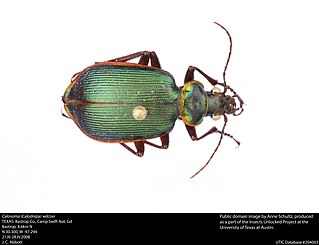
Ground beetles are a large, cosmopolitan family of beetles, the Carabidae, with more than 40,000 species worldwide, around 2,000 of which are found in North America and 2,700 in Europe. As of 2015, it is one of the 10 most species-rich animal families. They belong to the Adephaga. Members of the family are primarily carnivorous, but some members are herbivorous or omnivorous.

John Lawrence LeConte MD was an American entomologist, responsible for naming and describing approximately half of the insect taxa known in the United States during his lifetime, including some 5,000 species of beetles. He was recognized as the foremost authority on North American beetles during his career, and has been described as "the father of American beetle study".

Joseph Le Conte was a physician, geologist, professor at the University of California, Berkeley, early California conservationist, and eugenicist.

Mount Le Conte is a mountain located within the Great Smoky Mountains National Park in Sevier County, Tennessee. At 6,593 ft (2,010 m) it is the third highest peak in the national park, behind Kuwohi and Mount Guyot. It is also the highest peak that is completely within Tennessee. From its immediate base to its summit, Mount Le Conte is the mountain with the highest relief east of the Rocky Mountains, rising 5,301 ft (1,616 m) from its base, near Gatlinburg, Tennessee. For comparison, Pre-1980 Mount St. Helens in Washington was roughly 5,000 ft (1,524 m) above its base.

Calosoma sycophanta, the forest caterpillar hunter, is a species of ground beetle belonging to the family Carabidae.

Contes is a commune in the Pas-de-Calais department in the Hauts-de-France region of France.

Calosoma is a genus of large ground beetles that occur primarily throughout the Northern Hemisphere, and are referred to as caterpillar hunters or caterpillar searchers. Many of the 167 species are largely or entirely black, but some have bright metallic coloration. They produce a foul-smelling spray from glands near the tip of the abdomen. They are recognizable due to their large thorax, which is almost the size of their abdomen and much wider than their head.

Calosoma scrutator, commonly known as the fiery searcher and caterpillar hunter, is a species of ground beetle belonging to the genus Calosoma. This beetle can be as large as 35 millimetres (1.4 in) long, and is hence among the largest of the ground beetles found in North America. The distribution of this species is relatively widespread, and is common in North America. The adult beetle is known to excrete a foul-smelling oil when it is handled. The oil has been described as smelling similar to rotten milk or rancid olive oil.
Calosoma bridgesi is a brachypterous species of ground beetle in the subfamily of Carabinae. The species is 18–20 millimetres (0.71–0.79 in), is reddish-black coloured, and is endemic to the Andes mountains of Bolivia, Argentina, and Chile where it is found on elevation of 3,500 metres (11,500 ft). It flies in January and February.
Calosoma discors is a species of ground beetle in the subfamily Carabinae. It was described by John Lawrence LeConte in 1857.
Calosoma lepidum is a species of ground beetle in the subfamily Carabinae. It was described by John Lawrence LeConte in 1844.

Calosoma macrum is a species of ground beetle in the subfamily Carabinae. It was described by John Lawrence LeConte in 1853. The species is 24–30 millimetres (0.94–1.18 in) long, black, and lives at an elevation of 1,000 to 1,600 metres.
Calosoma moniliatum is a species in the beetle family Carabidae. It is found in the United States and Canada.
Calosoma prominens is a species of ground beetle in the subfamily Carabinae. It was described by John Lawrence LeConte in 1853.
Calosoma macrum is a species of ground beetle in the subfamily Carabinae. It was described by John Lawrence LeConte in 1852. The species is 22–29 millimetres (0.87–1.14 in) long, black, and lives at an elevation of 1,100 to 1,700 metres in Guerrero, Mexico. It flies in June and October.
Calosoma simplex is a species of ground beetle in the subfamily Carabinae. It was described by John Lawrence LeConte in 1878.
Calosoma tepidum is a species of ground beetle in the subfamily Carabinae. It was described by John Lawrence LeConte in 1851.

Calosoma wilcoxi is a species of ground beetle in the subfamily Carabinae. It was described by John Lawrence LeConte in 1848.
Calosoma wilkesii is a species in the beetle family Carabidae. It is found in the United States and Canada.









